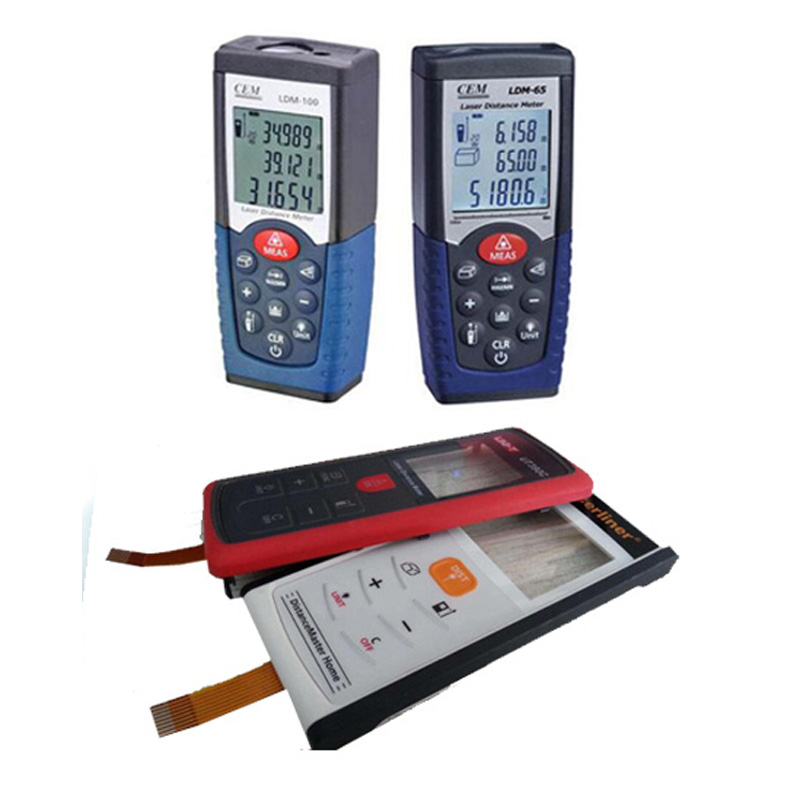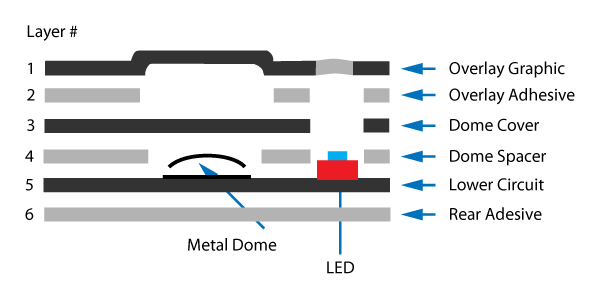How membrane switch increases durability and performance in healthcare
Wiki Article
Everything About Membrane Switch Over: A Comprehensive Overview for Beginners
Membrane buttons are important parts in contemporary electronics, using a distinct user interface for individual communication - membrane switch. Their layered construction, consisting of overlays and conductive traces, provides performance and durability. Unlike typical mechanical switches, membrane layer switches provide a sleek style and personalized options. Recognizing their essential attributes and benefits can change item style. Nonetheless, the complexities of their application and layout considerations call for additional expeditionWhat Is a Membrane Change?
A membrane layer switch is a type of electric button that includes a versatile membrane layer layered over a published circuit board. This design enables for a compact and smooth user interface, often utilized in different digital tools. Membrane buttons are generally found in consumer home appliances, clinical devices, and commercial equipment due to their toughness and resistance to ecological factors.The building and construction typically includes multiple layers, such as graphic overlays and sticky backing, which offer tactile comments and secure the wiring beneath. The procedure of a membrane switch is started when pressure is applied to the surface, completing an electrical circuit.These switches are valued for their versatility, enabling custom designs and published graphics that satisfy details customer interfaces. Their inconspicuous nature minimizes area demands, making them optimal for applications where standard buttons might not fit. On the whole, membrane layer buttons provide a visual and useful option for contemporary digital gadgets.Key Components of Membrane Switches
Membrane layer switches comprise several vital elements that contribute to their functionality and efficiency. The top layer, referred to as the overlay, provides the interface and is typically printed with graphics or symbols. Below the overlay lies a spacer layer, which divides the conductive aspects and avoids unintentional activation. The following vital part is the graphic layer, which enhances aesthetics and assures the sturdiness of the design.Conductive traces, generally made from products like silver or carbon, are printed on the circuit layer. When stress is put on the overlay, these traces come into get in touch with, completing the circuit. Furthermore, a backing layer uses structural assistance and can be made from materials such as polyester or polycarbonate. With each other, these components produce a dependable, straightforward interface ideal for various applications, from family appliances to commercial equipment. Comprehending these components is vital for any person thinking about membrane layer switch innovation.Just How Membrane Layer Switches Job
Recognizing how membrane switches over function is necessary for valuing their widespread use in different tools. A membrane switch operates with a collection of layers, consisting of a graphic overlay, spacer, and a circuit layer. When pressure is put on the overlay, it presses the spacer layer, permitting the circuit layer to make call and complete an electrical circuit. This action sends a signal to the gadget, motivating a feedback, such as activating a light or activating a function.Membrane changes can be created with different attributes, consisting of responsive responses, backlighting, and custom graphics, improving individual communication. Their building and construction allows for a closed style, securing the interior elements from dust, wetness, and pollutants. This toughness makes them ideal for varied applications, from customer electronics to industrial equipment. Overall, the simplicity and effectiveness of membrane switches over add to their appeal in contemporary technology.Advantages of Membrane Layer Switches Mechanical Buttons
While mechanical switches have long been a staple in many tools, membrane layer changes offer distinct benefits that make them significantly appealing. One considerable benefit is their slim profile, permitting even more small designs and better adaptability in product advancement. Additionally, membrane layer switches attribute a consistent surface, which improves aesthetic appeal and streamlines cleaning, making them suitable for settings where hygiene is critical.Another advantage is their resistance to dirt and moisture. Unlike mechanical buttons, which can be jeopardized by ecological aspects, membrane buttons offer a sealed user interface that safeguards versus pollutants - membrane switch. Furthermore, membrane layer switches generally have a longer life-span because of less relocating components, resulting in boosted toughness and reliability.Cost-effectiveness is also a notable advantage, as membrane layer switches can be generated in bulk with reduced manufacturing prices. These factors integrate to place membrane switches as a functional choice to conventional mechanical alternatives in various applicationsTypical Applications of Membrane Layer Switches Over
Membrane switches are extensively made use of in various industries, particularly in customer electronic devices and industrial control panels. In consumer tools, they provide a sleek, easy to use user interface, while in commercial setups, they enhance sturdiness and capability. Understanding these applications highlights the flexibility and functionality of membrane layer buttons in modern-day innovation.Customer Electronic Devices Devices
As consumer electronics remain to develop, membrane switches have come to be a preferred choice for a variety of devices as a result of their versatility and smooth style. These switches are typically located in smartphones, tablet computers, and remote controls, where space is limited and aesthetic appeals issue. Their low profile and customizable designs permit manufacturers to develop straightforward user interfaces that improve the general user experience. Additionally, membrane layer buttons are commonly used in devices such as microwaves and coffee machine, supplying intuitive control alternatives while withstanding wetness and dust. The resilience and reliability of membrane layer changes make them appropriate for everyday customer products, guaranteeing long life and regular performance. In general, their combination in customer electronics reflects a mix of performance and modern layout.Industrial Control Panels
The applications of membrane switches expand beyond customer electronics, locating considerable use in commercial control panels. These buttons are favored for their durability and resistance to rough atmospheres, making them ideal for making and process control setups. They provide a dependable user interface for operators to manage machinery, screen procedures, and change setups. Membrane buttons can be customized to fit specific operational demands, incorporating functions like backlighting and tactile comments, boosting user experience. Their inconspicuous layout permits combination right into various devices, while their capacity to endure spills, dirt, and extreme temperature levels warranties longevity. Generally, membrane layer switches add to safe and effective procedure in commercial applications, demonstrating their flexibility and efficiency sought after environments.Considerations for Designing Membrane Layer Switches Over
When designing membrane switches, choosing the ideal products is crucial to ensure resilience and performance. Furthermore, comprehending layer arrangement techniques can significantly impact the switch's performance and individual experience. These factors to consider play a crucial duty in developing reliable and reliable membrane switch designs.
Product Option Relevance
Product option plays an essential role in the design and functionality of membrane buttons. The picked products directly affect the button's longevity, tactile response, and total visual. Secret considerations include the substratum, which need to supply structural integrity while permitting for adaptability, and the visuals overlay, which needs to be immune to put on and environmental factors. Conductive products must ensure dependable electric efficiency, while adhesives should offer solid bonding without jeopardizing the switch's procedure. Furthermore, compatibility with manufacturing procedures and end-user atmospheres is vital; products should withstand differing temperatures, moisture levels, and chemical direct exposure. Eventually, ideal product selection not just improves the membrane layer switch's efficiency however see it here additionally adds to its longevity and individual contentment, making it an important aspect of the layout process.
Layer Arrangement Techniques

Regularly Asked Questions
Just How Lengthy Do Membrane Switches Over Generally Last?
Membrane layer switches typically have a life-span of 1 to 5 million cycles, depending upon use and environmental problems. Variables such as design high quality and operating regularity greatly influence their longevity and overall performance long life.
Can Membrane Switches Be Custom-made for Details Styles?
Membrane switches can indeed be tailored to fit particular designs, permitting for varied shapes, shades, and performances. This flexibility enables suppliers to customize these switches to meet one-of-a-kind visual and dig this operational needs successfully.What Materials Are Made Use Of in Membrane Switch Over Building?
Membrane buttons are usually constructed utilizing products such as polyester, polycarbonate, and adhesive layers. These products provide resistance, resilience, and versatility to ecological variables, ensuring the switches work properly in various applications and conditions.
Are Membrane Changes Water-proof or Resistant to Wetness?
Membrane layer buttons can be made to be moisture-resistant, utilizing specialized finishes and products. Nevertheless, their water resistant abilities rely on building and construction top quality and specific applications, making it necessary to examine demands for excellent efficiency in various atmospheres.Exactly How Are Membrane Switches Fixed if Harmed?
Fixing damaged membrane switches commonly entails changing the impacted layer or circuit. Specialists may also use conductive sticky or utilize specialized repair work kits, making certain capability is brought back without total replacement of the entire button assembly. Unlike traditional mechanical buttons, membrane layer switches offer a streamlined style and customizable alternatives. A membrane switch is a kind of electrical switch that is composed of a versatile membrane layer layered over a published circuit board. The operation of a membrane layer switch is initiated when stress is applied to the surface area, completing an electric content circuit.These switches are valued for their versatility, allowing customized layouts and printed graphics that provide to certain user interfaces. While mechanical buttons have long been a staple in lots of devices, membrane layer switches deal distinct benefits that make them increasingly appealing. Membrane layer switches normally have a longer lifespan due to less relocating parts, resulting in boosted resilience and reliability.Cost-effectiveness is additionally a noteworthy advantage, as membrane switches can be generated in bulk with lower production costs.Report this wiki page